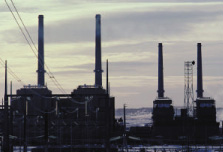
>President's
Column
>Catalyst
>Preserving
Records
>Science
and the Public
>IUPAC
Forum
>IUPAC
News
>Awards
>IUPAC
Projects
>Highlights
from PAC
>New
Books
>Reports
from Conferences
>Web
Reviews
>Conference
Announcements
>Conference
Calendar
Download the January
issue in pdf format.
(1.91 MB)
Chemistry International
Vol. 24, No. 1
January 2002
IUPAC News
Whither Green Chemistry?
A Look at CHEMRAWN XIV
What are the latest advances in green chemistry? How can green chemical processes be implemented for the benefit of all? What are the prospects for green chemical research and policies promoting such research to advance sustainable development around the globe? How is green chemistry best taught?
These questions were explored last June at a World Congress on Green Chemistry–CHEMRAWN XIV: Toward Environmentally Benign Processes and Products. More than 200 scientists, students, and policymakers– from more than two dozen countries–met in Boulder, Colorado. They learned that green chemistry is attracting more scientists to the discipline, that significant advances have been made in the use of alternate reaction media such as supercritical carbon dioxide, that high-yield bioprocesses offer a wealth of opportunities while avoiding the use of hazardous reactants, and that a number of new catalysts are powerful tools for advancing green chemistry.
The welcoming session included remarks by Organizing Committee Chairman J. Michael Fitzpatrick, President and Chief Operating Officer of Rohm and Haas; ACS Past-Presidents Attila E. Pavlath and Daryle H. Busch; Local Arrangements Chairman Professor Robert E. Sievers; IUPAC CHEMRAWN Committee Chairman Parry M. Norling; and Green Chemistry Institute Director Dennis L. Hjeresen.
Conference lecturers included Mary L. Good, President of the American Association for the Advancement of Science; Nobel Laureate Paul J. Crutzen, Professor Emeritus at the Max Planck Institute, Mainz, Germany; Rosina Bierbaum, Acting Director of the U.S. Office of Science and Technology Policy; Joseph M. DeSimone, chemical engineering Professor at the University of North Carolina; Joseph A. Miller, former Chief Science and Technology Officer at the DuPont Company; and Martin Poliakoff, Professor at the University of Nottingham, England.
While scientific papers, lively poster sessions, controversy, and debate were the center of the conference, a three-day pre-conference workshop was essential for 25 young scientists from 16 countries. The workshop provided training in concepts, fundamentals, methods of green chemistry, and a base for communication networks for participants. Expenses for the workshop were covered by the sponsors of the conference– IUPAC, national chemical societies such as the American Chemical Society and the Royal Society of Chemistry, the University of Colorado, a number of chemical companies including Rohm and Haas, and UNESCO.
Key lectures are published in the August 2001 issue of Pure and Applied Chemistry. Prefaced by Dennis L. Hjeresen and Paul T. Anastas, the series of manuscripts covers the following topics: global issues on chemistry and the environment, education and international programs, industrial processes and practices, and scientific advances in green chemistry.
An essential feature of all CHEMRAWN (CHEMical Research Applied to World Needs) conferences is the development of a set of actionable recommendations based on findings during the sessions. This task at CHEMRAWN XIV was carried out by a Future Actions Committee headed by Paul T. Anastas of the U.S. Office of Science and Technology Policy. The findings and proposed actions are summarized to in
http://www.iupac.org/standing/chemrawn/crXIVfac.html>
As the recommendations are implemented and as the young scientists continue their research and collaboration, the lasting impact of CHEMRAWN XIV will be realized.
News
and Notices - Organizations and People
- Standing Committees
Divisions
- Projects - Reports
- Publications - Symposia
- AMP - Links
Page last modified 20 December 2001.
Copyright © 1997-2001 International Union of Pure and Applied Chemistry.
Questions or comments about IUPAC, please
contact the Secretariat.
Questions regarding the website, please contact [email protected]

